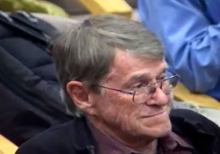| James "Jim" Moore | |
|---|---|
 Moore pictured in the audience of a U.S. Geological Survey event, 2015 Moore pictured in the audience of a U.S. Geological Survey event, 2015 | |
| Born | James Gregory Moore 30 April 1930 Palo Alto, California, U.S. |
| Awards | Penrose Medal (GSA) |
| Academic background | |
| Education | § Education |
| Website | www |
James Gregory Moore (born 30 April 1930, Palo Alto, California) is a geologist and winner of the 2020 Penrose Medal. Moore is a Scientist Emeritus for the U.S. Geological Survey.
Education
- Stanford University (BS, 1951)
- University of Washington (MS, 1952)
- Johns Hopkins University (PhD, 1954)
Career
James Moore has had a significant impact on the study of the structures of Hawaiian volcanoes. His studies in the field have contributed to the understanding that basaltic islands, like those in Hawaii, are susceptible to landslides or collapses, an event that could cause a tsunami. Accounts differ on when Moore served as Scientist-in-Charge of the Hawaiian Volcano Observatory. He was posted 1961 or 1962, and served until 1963 or 1964.
Moore was also one of the geologists on the scene of the eruption following the 1980 eruption of Mount St. Helens. He was crucial in determining the order of events leading up to, and following after the eruption and measuring the volumes of resulting landslides. He has also researched extensively in the Lassen area of California as well as in the Sierra Nevada.
Books
Moore is also the author of 2 notable books, Exploring the Highest Sierra [Wikidata] and King of the 40th Parallel [Wikidata].
References
- ^ Nemeh, Katherine H., ed. (2008). "Moore, James Gregory". American Men & Women of Science: A Biographical Directory of Today's Leaders in Physical, Biological, and Related Sciences. Vol. 5 (25th ed.). Gale. Gale CX3099108524.
- "PubTalk 3/2004 — Mapping the American West". U.S. Geological Survey. Retrieved 2023-04-17.
- "2020 Penrose Medal". The Geological Society of America. Retrieved 2023-04-17.
- "James G Moore [Person]". ScienceBase-Directory. U.S. Geological Survey. Retrieved 2023-04-17.
- Coombs, Michelle; Eakins, Barry; Cervelli, Peter (2006-03-01). "Growth and Collapse of Hawaiian Volcanoes". Journal of Volcanology and Geothermal Research. 151 (1): vii–viii. Bibcode:2006JVGR..151D...7C. doi:10.1016/j.jvolgeores.2005.07.022. ISSN 0377-0273.
- "Hawaiian Volcanism". Volcano World. Oregon State University. 2010-04-08. Retrieved 2023-05-01.
- "Acknowledgments". Hawai‘i Groundwater & Geothermal Resources Center. University of Hawaii at Manoa. Retrieved 2023-05-01.
- "Volcano Watch — The Canary Islands "mega-tsunami" hypothesis, and why it doesn't carry water". U.S. Geological Survey. October 21, 2021. Retrieved 2023-04-17.
- ^ "James G Moore". U.S. Geological Survey. Retrieved 2023-04-17.
- Babb, Janet L.; Kauahikaua, James P.; Tilling, Robert I. (2011). "The story of the Hawaiian Volcano Observatory—A remarkable first 100 years of tracking eruptions and earthquakes". U.S. Geological Survey General Information Product 135. General Information Product: i-63. doi:10.3133/gip135.
- "Slip-Sliding Away—Disassembling Hawaiian Volcanoes". Pacific Island National Parks. Wordpress. 2014-01-24. Retrieved 2023-04-17.
- "May 18, 1980 Mount St. Helens Eruption: Stories from USGS Scientists". U.S. Geological Survey. Retrieved 2023-04-17.
- "PubTalk 04/2015—"Fearfully Grand" Eruptions: Lassen Peak, CA, 1914-17". U.S. Geological Survey. Retrieved 2023-04-17.